“Well, we made it here alive,” I say. For the first time in my life, those words do not seem as hyperbolic as when I have used them in the past. We are walking down a street in Lashio, heading for a tea shop after having some Shan cuisine.
Danielle looks at me, grins, and says, “Yea, we did.”
Our day began with rain and piling into a shockless four-door Nissan. Danielle and I got into the back, and the local teacher, Soe, sat in the front seat. He turned and told us that one of his good friends, a school-mate from university, would be accompanying us to Lashio. We nodded in accession.
The taxi driver, hereafter referred to as Bob, drove us off into the southern portions of Mandalay to pick up Soe’s friend and copies of Soe’s book, Structural English. The plan was to head to Lashio for nine days to teach and provide English language training for teachers located in the more remote area of northern Shan State, Myanmar.
Lashio is one of only a few towns hidden among the Shan mountains in northern Shan State. It is approximately 120 miles (~200 km) northeast of Mandalay. The turbulent history of Myanmar has been marked by a nearly five decade civil dispute for independence between Shan State and the ruling government. Shan State claims a diverse ethnic and cultural background—Chin, Kachin, Wa, Ta’ang, Palaung, and Lahu people. Crammed between Thailand, China, and central Myanmar, they are largely seen as the hill people who are not to be trifled with. They are the rebels, and many different ethnic groups boast their own armies. Most ethnic, political, or insurgent armies fund their operations through the production of opium, only second to Afghanistan in international export. In the 50’s, the U.S. helped the Kuomintang (the National Party of China who currently govern Taiwan) overtake Shan State as a base of operations for the KMT to regain control of communist China. However, Myanmar forces drove the KMT back toward the eastern borders of Myanmar where they have existed ever since. In addition, China and Thailand have indirectly funded armies in the area over the last 30-40 years in an effort to satisfy their own agendas.
After picking up Soe’s friend, Yen, our taxi driver takes us out of the back streets of Mandalay and turns eastward. The Shan mountains loom directly in front of us and over Mandalay.
The transition from city to country is seamless and is only marked by a change in scenery—open city streets and buildings give way to dense and canopied jungle. Our departure from Mandalay is marked by a quick stop for Bob—he buys a train of star-flower petals and hangs them on the rear-view mirror. I enjoy the pleasant smell, but they are definitely pungent and noxious. I know they are related to the veneration of Buddha, but in this case I wonder if they are for good luck, general blessing, or just to have a safe trip.
As we drive toward the foot of the mountains, I can only guess how far we are from them—the canopy is just too thick. Instead of looking up, I look out as we drive for the next 45 minutes. Small village homes, farms, and timber enterprises fill my vision. We pass an occasional road-side stand attended by the usual suspects—two or three people reclining in wicker chairs and sucking on betel which is so popular here due to its stimulating effects.
Large rock formations rise up from the ground to pierce the dense jungle and I get an occasional glimpse of the mountains in front of us. Large sections of the base have been carved out for quarrying rock.
The canopy breaks and I get my first close up of the mountains I have only seen on the horizon during my time in Mandalay. The car putters up the first switchback as we begin to make our climb. Unbeknownst to Danielle and me, we will spend the next five hours climbing up and down as we wind our way through the hills toward Lashio. Roads in Myanmar are not well-maintained so they are uneven, pot-holed, and unsympathetic to long car rides. The state of the roads combined with our shockless taxi produce a nauseating effect as Bob tries to rocket us to Lashio. As I write this entry, I’ve already forgotten how many times we bottomed out that day.
Our taxi-driver-turned-rally-car-driver sling shots us around each switchback as he passes vehicles on the left and right. Each time Bob passes, he honks interminably. I grip the arm rest and cast furtive glances at Danielle. She has already slid into Soe’s lap multiple times as we round the corners.
Thirty minutes later the adrenaline pump in my heart is running on dregs and I’ve reasoned myself into delusion—no more fear, just looking to kill time until we reach Lashio.
Three hours into our trip and we have reached the valley of the Gohtwin stream where one of the world’s largest steel railway trestles, the Goteik viaduct, was built in 1900 by the Pennsylvania and Maryland Bridge Construction company. It is approximately 2,200 feet long and stands approximately 330 feet above the ground. One-hundred and fourteen years later it still stands as the main crossing point over the Gohtwin stream for trains between Mandalay and Lashio.
While we zoom down the eastern side of the valley, I can see the trestle in the south end. Its silver beams are clearly perceptible against the backdrop of the verdant jungle. Its origin and terminus on each side of the valley are unseen. So lonely, it looks like a decaying vestige of British colonial rule.
Once on top of the mountain range in Shan state, most of the landscape is gently rolling hills (quite similar to the hill country in central Texas where I grew up). However, the Gohtwin stream has carved a rift through this part of the country and large red cliffs permeate the dense jungle along the walls of the valley. I try to take pictures but we are traveling too fast and the road is too bumpy for any good stills.
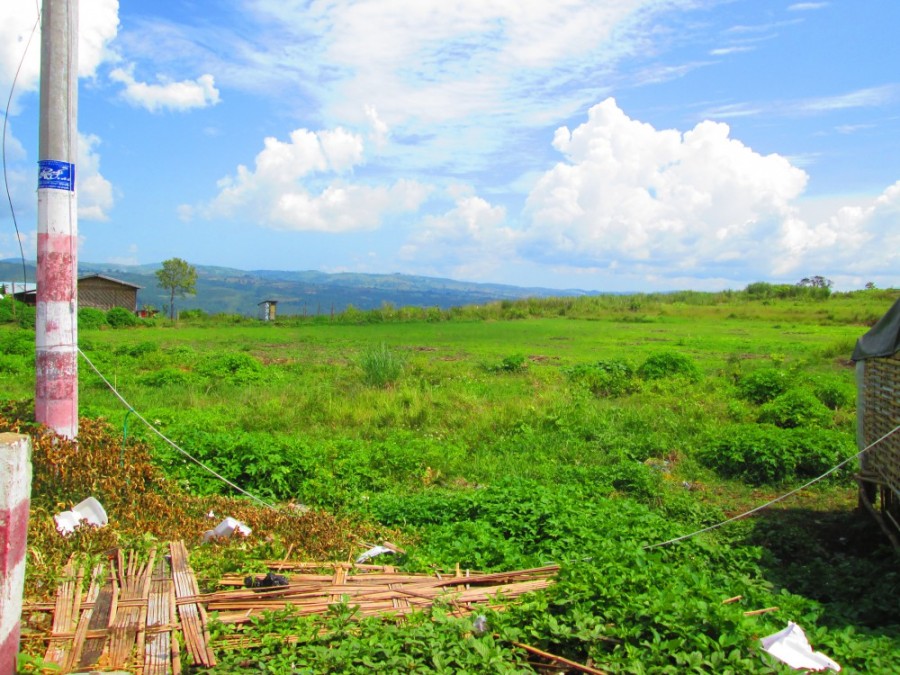
At the bottom of the valley, we pass a military outpost that seems deserted. No one is manning the guard towers and there seems to be no activity within the compound. I wonder if it’s abandoned or if everyone is just inside the building relaxing. All I’ve seen of the military in Myanmar is men sitting in the shade and relaxing with their starched uniforms and assault rifles.
Our taxi slowly climbs the western side of the valley. This side is particularly steep—the grade of the roads is at such an angle that I begin to wonder if anyone considered the prospect of travel when it was built. The engine strains as we climb, and outside my window I watch as other motorbikes and heavy duty transport trucks struggle with the grade. Further up the mountain, the switchbacks lengthen and become less graded, making our climb easier. We pass a rest-stop.
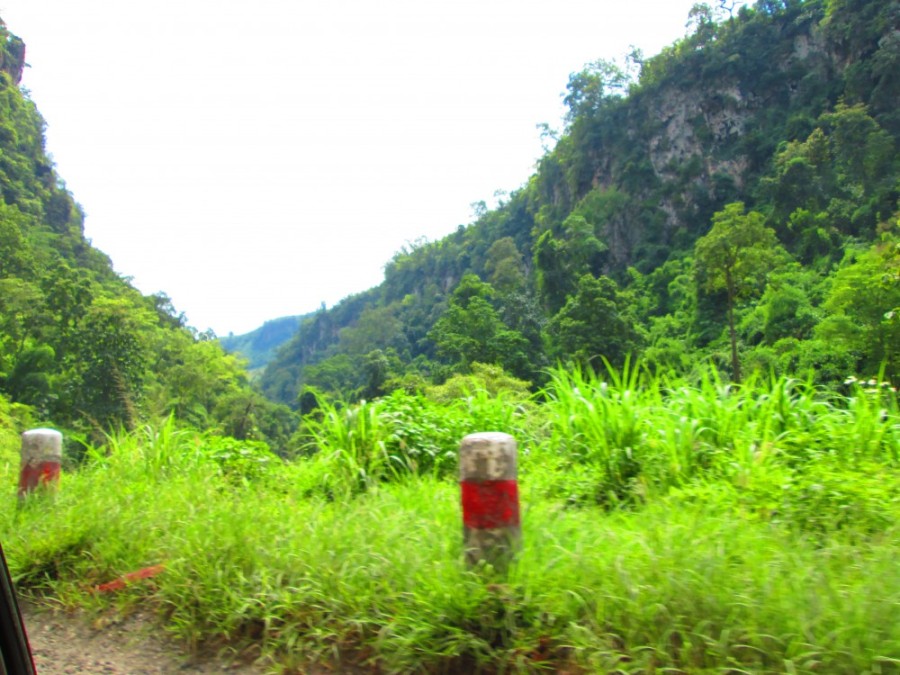
As we travel further up the valley through dozen of switchbacks, we get caught behind a column of military transports. The men in the backs of the trucks are of varying ages and have the hung expression of the U.S. soldiers you always see in movies about the Vietnam war. Our taxi pulls up behind the first truck and I wonder if we’ll pass—in America, I don’t think most people would attempt any pass behind a column of military vehicles unless there is more than one lane. However, we begin to slowly overtake one truck after another. The column is longer than I expect but we finally reach the fifth of sixth truck behind the leader. However, the pace of the trucks has slowed considerably.
We pass a broken-down van on the side of the road. A family or a group of people mill about while two men repair it.
The column stops. There are two civilian vehicles directly in front of us and they have stopped as well. Bob slows down the taxi to assess the situation and I begin to get that strange feeling inside when my powers of observation tell my intuition that something is wrong. A couple of men jump out of the back of the first truck and wander into the bushes on the side of the road. ‘Ah, it must be a bathroom break,’ I think. However, men keep streaming out of the back of the first truck and are succeeded by men from the other trucks now. Soe and Yen look at me while throwing their hands in the air. Their faces tell me they have no idea what is happening and then Yen says, “I don’t know what is going on.” I look up at the first vehicle and see one of the soldiers hunker down in the ditch. The others begin combing the jungle with their rifle stocks on the side of the road.
Bob and I make the same intuitive leap. He exits the column of civilian and military vehicles and places us perpendicular to the road. We are both still watching out the window. Danielle is half-asleep on my right side and Soe is on my left.
“POP!”
It is the all too familiar sound from my childhood in Texas—a gun shot.
After the first shot, Bob is already wheeling the taxi around to head back down the mountain. I hear a couple of more single-fire “POPs” before the air becomes filled with the “popping” of automatic weapons as the fire-fight breaks out. Bob’s rally car skills come into play as he pushes on the accelerator. I briefly catch sight of the broken-down van. Bob barely slows for the first curve. As we take the curve, I vaguely remember looking at Danielle next to me:
“BOOM!”
For a split second, I think someone is firing artillery at us. My next thought is that Danielle and Bob would be dead if they were—the blast was only ten feet away on the right side of the taxi.
The explosion prompts Bob to careen down the rest of the switchbacks. I tell Danielle to switch seats with me. I am waiting for the next blast to come, or the shattering of glass as bullets begin to pierce the taxi.
Nothing ever comes.
I look at the star-flower petals rocking back and forth on the rear-view mirror. They are wilted and turning brown, but I begin to wonder if they have given their life for ours. We wave down, flash our lights, and yell at any of the vehicles who are coming up the mountain. They all stop, promptly turn around, and follow us. We pull into the rest stop with all the other cars that have retreated from the fire-fight. After Bob parks, he jumps out of the car and starts running around and shouting in Myanma to other locals. I presume that he is telling them of our adventure by his gesticulations and onomatopoeia.
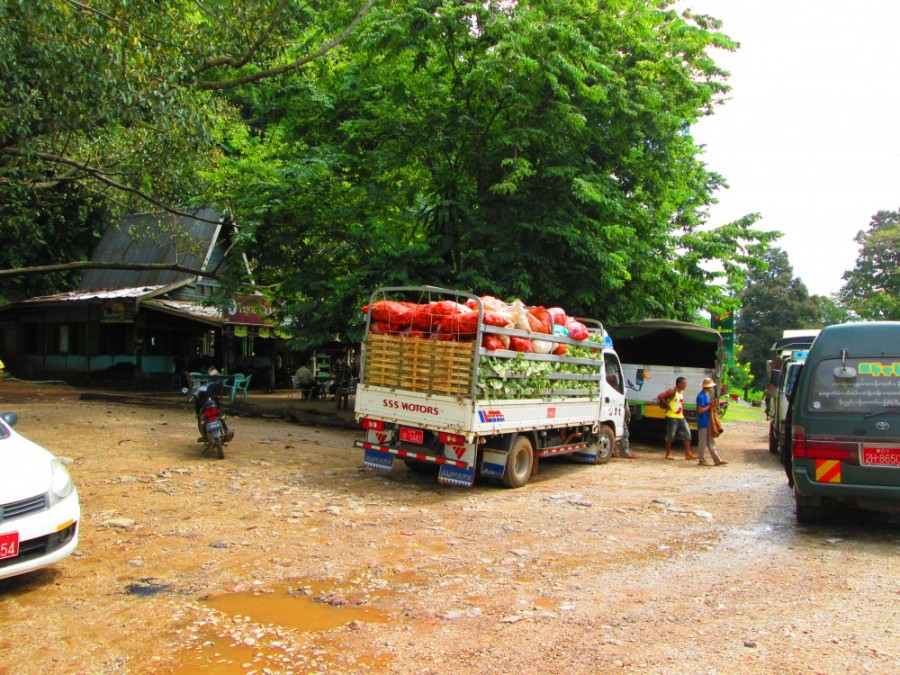
Soe, Yen, and Danielle pile out of the car with me. Soe and Yen walk off while I check on Danielle. She is rifling through her bag–she pulls out an apple and starts munching on it. I smile.
I look around as more and more cars, trucks, transports, and semi-trucks keep pulling into the rest stop. Among the crowd of people next to one of the transport vans is a foreign face. I walk over and inquire if he speaks English. Fortunately, he does and asks:
“You know what’s going on?”
“Yea,” I reply. “The military seemed occupied with someone on the mountain. They started shooting so we came back down.”
He nods. “We stopped at this rest stop on the way down. We left Lashio this morning. The news said there was a skirmish in this area yesterday.” He grimaces and continues, “It might be smart if you head back to Mandalay.”
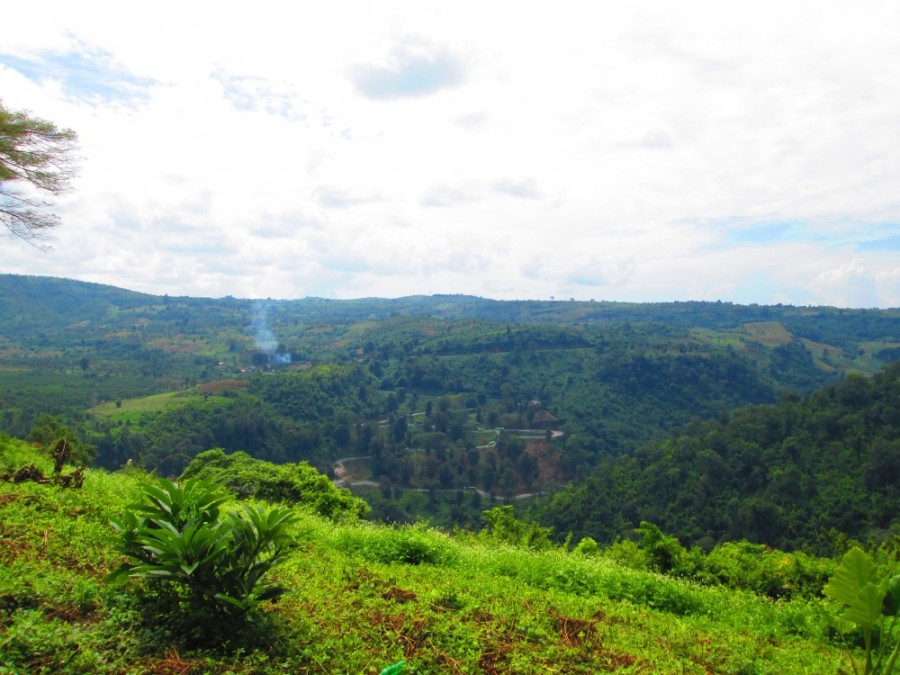
I nod my head and tell him “Thanks” for the information. I walk back over to my taxi group. Danielle is still munching on the apple, Soe and Yen are sitting on a tree bench, and Bob is still running around. Soe is visibly shaking while I tell them what I’ve learned from the foreigner. I ask Soe what we’re going to do next. He shakes his head, pulls out his phone, and calls the boss.
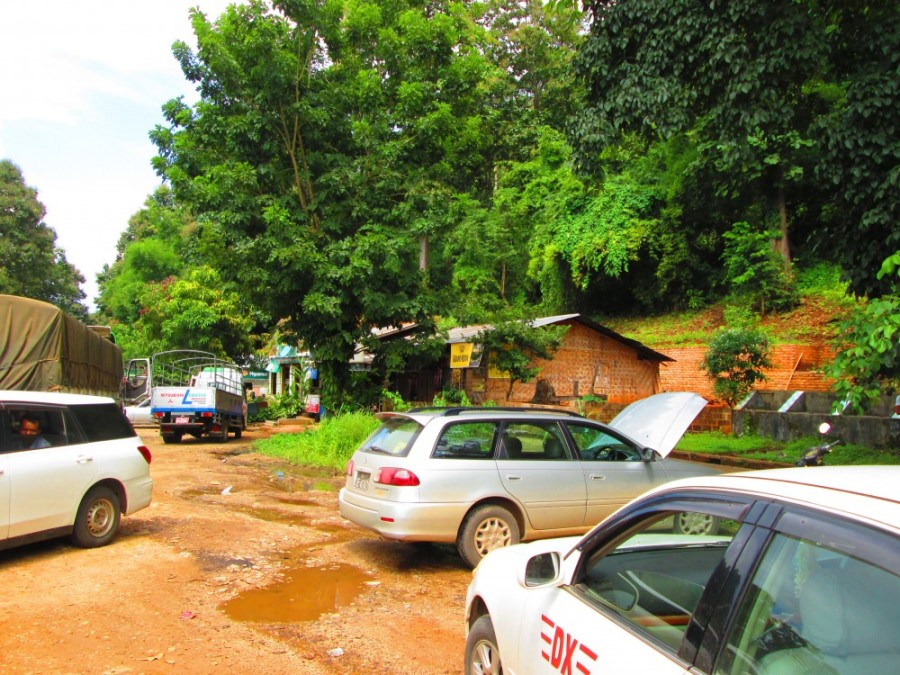
Thirty minutes later we decide to continue our trip up the mountain. Other vehicles have already left the rest stop. When our taxi returns back to the scene of the fire-fight, the soldiers are keeping an eye out for movement. We pass the switchback where the bomb went off and I see a soldier crouched in the small crater. As we continue, most of the soldiers are milling about the area.
They stare at us as we pass and we stare back.


I’m glad you made it out of your adventure safely. I laughed when I read about my brave Danielle only concerned with her apple. lol What a wild ride.
LikeLike
Yes, I’m always surprised by Danielle’s nonchalant attitude toward a lot of things. I always laugh and she says, “What?!?!” I really appreciate that type of approach to life though.
LikeLike
[…] took approximately 6-7 hours due to multiple stops for nutrient intake, a military skirmish (see Civil War in Myanmar), and multiple stops for waste disposal. While I am the type of person who likes to travel without […]
LikeLike
You two are very brave. I did snicker at intervals. What a wonderful adventure. I glad I wasn’t there to make a scene. My first name is chicken.
LikeLike
[…] adventures throughout Asia. I told him about our experiences in Myanmar with teaching, civil war, and the unique culture that existed there–how nostalgic I was to talk about Myanmar. He […]
LikeLike